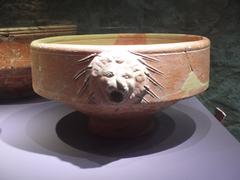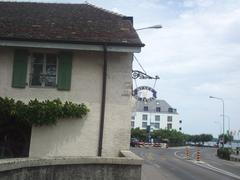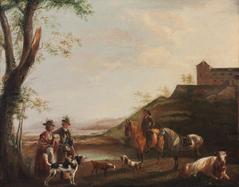
Visiting Nyon Roman Museum in Nyon, Switzerland: Tickets, Hours, and Guide
Date: 01/08/2024
Introduction
Nyon, a picturesque town perched on the shores of Lake Geneva, Switzerland, is a haven for history enthusiasts and casual travelers alike. Renowned for its substantial Roman heritage, Nyon, originally known as Noviodunum, was established around 45 BCE under the aegis of Julius Caesar. The town flourished as part of the Roman Colonia Iulia Equestris, an administrative and military region pivotal to the Roman Empire’s expansion in the area. The Nyon Roman Museum, housed in the foundations of a first-century Roman basilica, offers visitors an immersive journey into this ancient world. The museum’s exhibits showcase a diverse array of artifacts, from everyday items like ceramic dishes and oil lamps to more significant archaeological finds such as coins and sculptures. These artifacts not only highlight the daily life of the Roman era but also the architectural prowess and strategic significance of Noviodunum (Spotting History). This guide aims to provide comprehensive insights into the museum’s historical context, visitor information, and practical tips to ensure a fulfilling visit.
Table of Contents
- Introduction
- Historical Background
- Visitor Information
- Archaeological Discoveries
- Travel Tips and Nearby Attractions
- Human Presence Before the Romans
- Preservation and Modern-Day Significance
- Continued Archaeological Potential
- Cultural Impact and Educational Value
- Integration with Modern Nyon
- FAQ
- Conclusion
Historical Background
Roman Foundations and Julius Caesar’s Influence
Nyon, known in Roman times as Noviodunum, owes its origins to Julius Caesar. Around 45 BC, shortly after the conclusion of the Gallic War, Caesar established a Roman colony on the shores of Lake Geneva. This colony, named Colonia Iulia Equestris, was intended as a settlement for veterans of his army, particularly those from the cavalry, as indicated by the term “Equestris” (source). The strategic location of this colony was crucial for consolidating Roman presence in the region, stretching along the right bank of the Rhône, encompassing areas such as the Pays de Gex, the Jura, and the Côte vaudoise.
Urban Development and Architectural Marvels
The Roman town of Noviodunum was meticulously planned and constructed, mirroring the grandeur of Rome itself. The city featured a forum, basilica, dwellings, necropolises, a macellum (covered market), artisanal areas, an aqueduct, thermal baths, and an amphitheater (source). These structures not only served practical purposes but also symbolized the might and sophistication of the Roman Empire.
Decline and Legacy
Despite its initial prominence, Colonia Iulia Equestris began to decline by the end of the 3rd century AD. The once-thriving city saw its monuments fall into ruin, with materials repurposed for construction in surrounding areas such as Nyon, Geneva, and Lausanne (source). This phase of decline marked the end of an era, but the remnants of Roman architecture continued to influence the region’s development.
Visitor Information
Nyon Roman Museum Visiting Hours and Tickets
The Musée Romain de Nyon, located at Rue Maupertuis 9, is dedicated to preserving the city’s Roman heritage. The museum is open from Tuesday to Sunday, 10:00 AM to 5:00 PM. Admission fees are as follows:
- Adults: CHF 8
- Students and Seniors: CHF 6
- Children (6-16 years): CHF 4
- Free entry for children under 6 years
For more information, visit the official website.
Archaeological Discoveries
Nyon’s rich archaeological heritage has been unearthed through numerous excavations over the years. The city’s ancient past is visible in its streets, where Roman blocks can still be seen integrated into old facades (source). The Musée Romain de Nyon plays a pivotal role in preserving and showcasing these artifacts, offering a glimpse into the lives of Noviodunum’s inhabitants.
Travel Tips and Nearby Attractions
- Travel Tips: Nyon is easily accessible by train from Geneva and Lausanne, making it a convenient day trip. Comfortable walking shoes are recommended for exploring the town’s historical sites.
- Nearby Attractions: Apart from the Roman museum, visitors can explore Nyon Castle, the Lake Geneva waterfront, and the medieval old town.
Human Presence Before the Romans
Human presence in the Nyon area predates the Roman era, with evidence of habitation dating back to the Neolithic period. A Late Bronze Age site has been identified on the outskirts of Nyon, and the area was likely occupied during the Iron Age (source). However, the most significant archaeological remains in the town center are from Roman times, underscoring the lasting impact of Roman colonization.
Preservation and Modern-Day Significance
The Musée Romain de Nyon is situated in the foundations of a 1st-century basilica, providing a unique setting for its multimedia displays that delve into Nyon’s Roman beginnings. The museum’s efforts ensure that the legacy of Colonia Iulia Equestris remains accessible to the public, offering educational and cultural insights into this historical period.
Continued Archaeological Potential
The potential for further archaeological discoveries in Nyon is immense. The town’s development continues to reveal new elements of its ancient past, with many sites still unexplored. This ongoing process highlights the dynamic relationship between Nyon’s modern identity and its historical roots.
Cultural Impact and Educational Value
The preservation of Nyon’s Roman heritage has significant cultural and educational value. The artifacts and structures unearthed provide a tangible connection to the past, allowing visitors to explore the daily lives, architectural achievements, and societal structures of the Roman era. The Musée Romain de Nyon serves as a custodian of this heritage, offering curated exhibits and educational programs that enrich the understanding of Roman history.
Integration with Modern Nyon
Nyon’s integration of its Roman past with its modern identity is evident in its urban landscape. The town’s center has remained largely unchanged since antiquity, with Roman remains seamlessly blending into contemporary structures. This unique juxtaposition creates a living museum, where history is not confined to a single location but is interwoven with the fabric of everyday life.
FAQ
What are the visiting hours for the Musée Romain de Nyon? The museum is open from Tuesday to Sunday, 10:00 AM to 5:00 PM.
How much are the tickets for the Musée Romain de Nyon?
- Adults: CHF 8
- Students and Seniors: CHF 6
- Children (6-16 years): CHF 4
- Free entry for children under 6 years
Are there any travel tips for visiting Nyon? Nyon is easily accessible by train from Geneva and Lausanne, making it a convenient day trip. Comfortable walking shoes are recommended for exploring the town’s historical sites.
Conclusion
The historical background of Nyon, particularly its Roman heritage, is a testament to the enduring legacy of Colonia Iulia Equestris. From its founding by Julius Caesar to its decline and subsequent rediscovery, Nyon’s Roman past continues to shape its present and future. The Musée Romain de Nyon stands as a beacon of this rich history, preserving and celebrating the city’s ancient roots for generations to come. For more insights and updates, download the mobile app Audiala and follow us on social media.




